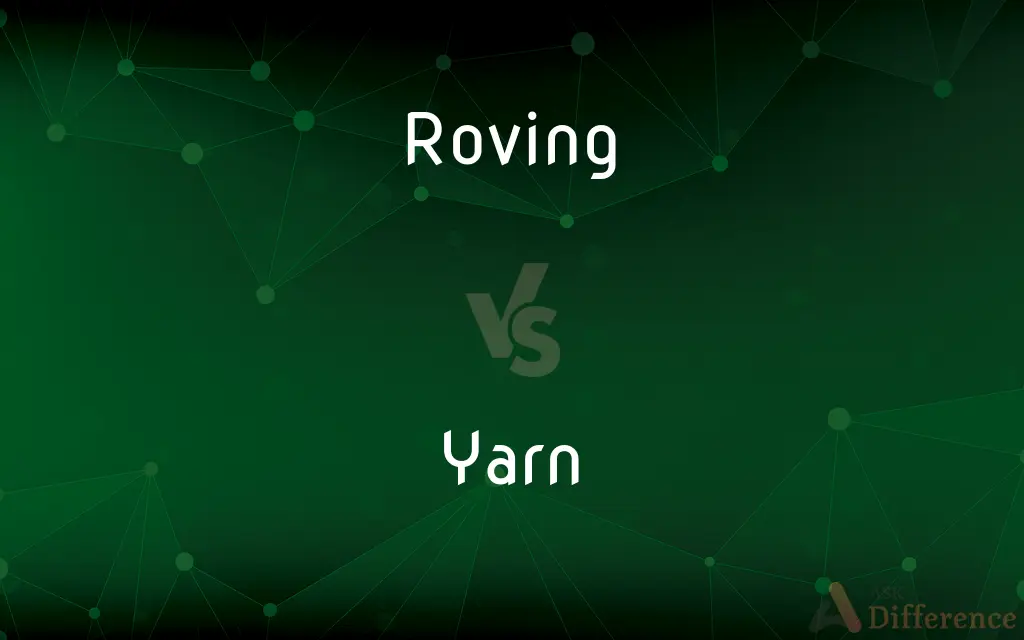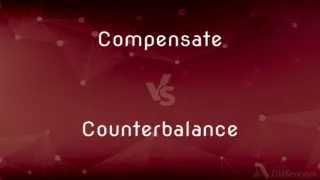Roving vs. Yarn — What's the Difference?
By Maham Liaqat & Fiza Rafique — Updated on March 31, 2024
Roving is a loosely organized bundle of fibers, while yarn is a long, continuous length of interlocked fibers.

Difference Between Roving and Yarn
Table of Contents
ADVERTISEMENT
Key Differences
Roving refers to a collection of fibers that have been carded or combed, aligning the fibers to prepare them for spinning but leaving them in a loose, unspun state. Yarn, on the other hand, is made by spinning or twisting fibers together to create a long, continuous strand.
One key difference between roving and yarn is their stage in the fiber processing journey. Roving is an intermediate product that is further processed to become yarn. It is in a more raw, unspun form, which makes it softer and loftier but also more delicate and less durable than yarn. Yarn, being fully spun, is more compact, strong, and ready for use in various textile crafts.
The texture and appearance of roving and yarn are also distinct. Roving tends to have a fluffier, airier texture due to its loose fibers, which can be appealing for certain crafts like needle felting or for creating textured yarns. Yarn, with its twisted or spun fibers, has a more defined structure, allowing for a wide range of creative possibilities in knitting, crocheting, and weaving projects.
Roving and yarn serve different purposes in the crafting world. While roving is primarily used for spinning into yarn or felting, yarn is the material of choice for creating fabric through techniques like knitting, crocheting, and weaving. This distinction highlights the versatility of fiber arts and the importance of understanding the properties of different materials for specific projects.
Comparison Chart
State
Loosely organized, unspun fibers
Long, continuous length of interlocked fibers
ADVERTISEMENT
Use
Spinning into yarn, felting
Knitting, crocheting, weaving, sewing
Texture
Fluffy, airy, delicate
Varied (can be smooth, rough, thick, thin), more durable
Material Stage
Intermediate product
Final product
Craft Possibilities
Primarily used for hand spinning and felting
Used in a wide range of textile crafts
Compare with Definitions
Roving
It represents an intermediate stage in fiber processing.
After carding the wool, we now have roving ready for spinning into yarn.
Yarn
Suitable for knitting, crocheting, weaving, and sewing.
She chose a vibrant yarn for her crochet blanket project.
Roving
Known for its fluffy and airy texture.
The roving's texture added a unique softness to the felted animals.
Yarn
Yarn is created by spinning or twisting fibers together.
The yarn was strong and uniform, ideal for her knitting project.
Roving
Roving consists of loosely organized fibers, often used for hand spinning.
The wool roving felt soft and airy, perfect for spinning.
Yarn
Made from natural or synthetic fibers.
The cotton yarn was perfect for her summer top due to its breathability.
Roving
Can be made from wool, cotton, or synthetic fibers.
She preferred using alpaca roving for its softness and warmth.
Yarn
Offers more strength and structure for textile crafts.
The tightly spun yarn provided excellent durability for the woven rug.
Roving
Primarily used for spinning into yarn or felting projects.
The colorful roving was ideal for her needle felting landscape.
Yarn
Comes in a variety of textures and thicknesses.
For the sweater, he selected a thick, woolen yarn.
Roving
A roving is a long and narrow bundle of fiber. Rovings are produced during the process of making spun yarn from wool fleece, raw cotton, or other fibres.
Yarn
Yarn is a long continuous length of interlocked fibres, suitable for use in the production of textiles, sewing, crocheting, knitting, weaving, embroidery, or ropemaking. Thread is a type of yarn intended for sewing by hand or machine.
Roving
A continuous strand of loosely twisted and drawn fibers, such as wool, flax, silk, or cotton, ready to be spun.
Yarn
A continuous strand of twisted threads of natural or synthetic fibers, such as wool or nylon, used in weaving or knitting.
Roving
Moving about; having no fixed or permanent abode; travelling from place to place.
Yarn
A similar strand of other materials such as glass or plastic.
Roving
Of the eyes or gaze, inspecting all over; not staying fixed on on subject.
His roving eyes never focused on anything specific.
Yarn
(Informal) A long, often elaborate narrative of real or fictitious adventures; an entertaining tale.
Roving
A long and narrow bundle of fibre, usually used to spin woollen yarn or in felting.
Yarn
To tell an entertaining tale or series of tales.
Roving
The process of giving the first twist to yarn.
Yarn
(uncountable) A twisted strand of fiber used for knitting or weaving.
Roving
Present participle of rove
Yarn
(nautical) Bundles of fibers twisted together, and which in turn are twisted in bundles to form strands, which in their turn are twisted or plaited to form rope.
Roving
The operatin of forming the rove, or slightly twisted sliver or roll of wool or cotton, by means of a machine for the purpose, called a roving frame, or roving machine.
Yarn
(countable) A story, a tale, especially one that is incredible.
Roving
A roll or sliver of wool or cotton drawn out and slightly twisted; a rove. See 2d Rove, 2.
Yarn
To tell a story or stories, especially one that is lengthy or unlikely to be true.
Roving
The act of one who roves or wanders.
Yarn
Spun wool; woolen thread; also, thread of other material, as of cotton, flax, hemp, or silk; material spun and prepared for use in weaving, knitting, manufacturing sewing thread, or the like.
Roving
Travelling about without any clear destination;
She followed him in his wanderings and looked after him
Yarn
One of the threads of which the strands of a rope are composed.
Roving
(of groups of people) tending to travel and change settlements frequently;
A restless mobile society
The nomadic habits of the Bedouins
Believed the profession of a peregrine typist would have a happy future
Wandering tribes
Yarn
A story told by a sailor for the amusement of his companions; a story or tale; as, to spin a yarn.
Yarn
The act of giving an account describing incidents or a course of events;
His narration was hesitant
Yarn
A fine cord of twisted fibers (of cotton or silk or wool or nylon etc.) used in sewing and weaving
Yarn
Tell or spin a yarn
Common Curiosities
Can roving be used directly in knitting or crocheting?
While technically possible for certain projects, roving is generally too delicate and unspun for standard knitting or crocheting.
What is roving?
Roving is a loosely organized bundle of fibers, typically used for spinning into yarn or for felting projects.
What is yarn?
Yarn is a long, continuous length of interlocked fibers, created by spinning or twisting, used in knitting, crocheting, weaving, and sewing.
What are the main physical differences between roving and yarn?
Roving is fluffy and airy with loose fibers, while yarn is more structured and can vary in texture and thickness.
How do roving and yarn differ in use?
Roving is primarily used for spinning into yarn or for felting, whereas yarn is used in a variety of textile crafts like knitting and crocheting.
What materials can be used to make roving and yarn?
Both can be made from a variety of materials, including wool, cotton, and synthetic fibers.
Can both roving and yarn be dyed?
Yes, both can be dyed, though the process and results might vary due to their different textures and absorbency.
Can synthetic fibers be used for roving?
Yes, synthetic fibers can be processed into roving, just like natural fibers.
How do you store roving and yarn to prevent tangling?
Roving should be stored gently to maintain its structure, while yarn can be wound into balls or skeins to prevent tangling.
Can you felt with yarn as you do with roving?
While felting is more commonly done with roving due to its loose fibers, yarn can also be used for felting, especially if it is 100% wool and not superwash.
What projects are best suited for yarn?
Yarn is ideal for projects requiring durability and structure, such as clothing, accessories, and home décor.
Why is roving preferred for spinning?
Its loose, unspun state makes it easier to draft (pull and twist) the fibers during the spinning process.
Is yarn more durable than roving?
Yes, because yarn is spun or twisted, it has more strength and durability than the loosely organized fibers of roving.
Is it easier to work with yarn or roving for beginners?
Yarn is generally easier and more forgiving for beginners in crafts like knitting and crocheting, due to its durability and structure.
Share Your Discovery

Previous Comparison
Compensate vs. Counterbalance
Next Comparison
Pride vs. LoveAuthor Spotlight
Written by
Maham LiaqatCo-written by
Fiza RafiqueFiza Rafique is a skilled content writer at AskDifference.com, where she meticulously refines and enhances written pieces. Drawing from her vast editorial expertise, Fiza ensures clarity, accuracy, and precision in every article. Passionate about language, she continually seeks to elevate the quality of content for readers worldwide.














































